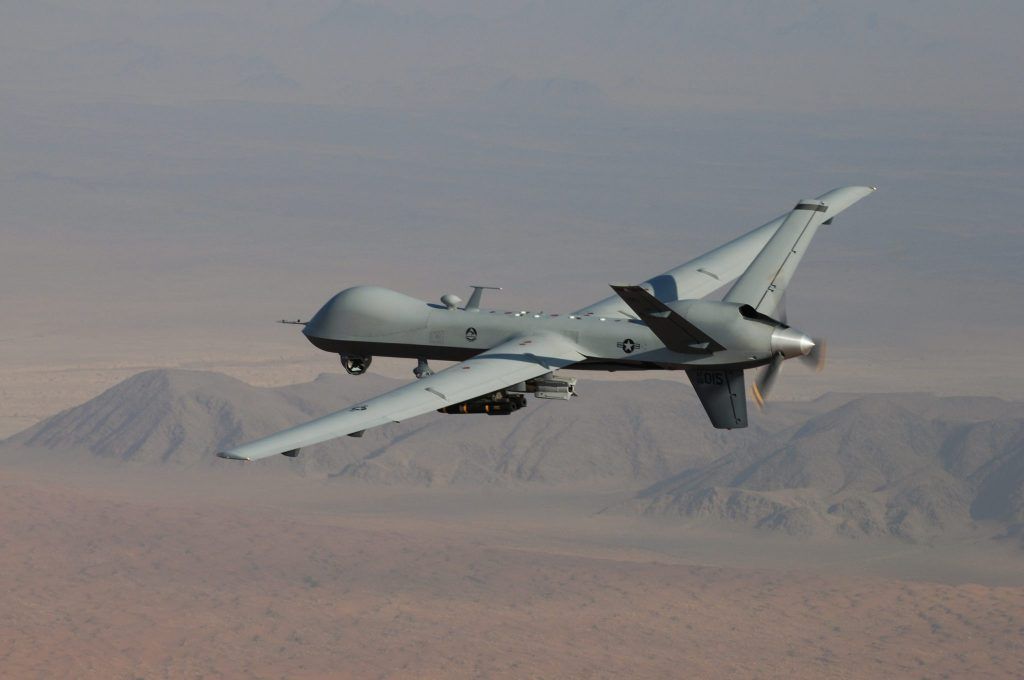A way to rein in drone proliferation
By Perry World House | November 30, 2018
 An MQ-9 Reaper flies a combat mission over southern Afghanistan. (Photo credit: US Air Force / Lt. Col. Leslie Pratt)
An MQ-9 Reaper flies a combat mission over southern Afghanistan. (Photo credit: US Air Force / Lt. Col. Leslie Pratt)
The proliferation of military drones worldwide is accelerating at an alarming rate, due to the willingness of certain states, like China, to export them widely. Eighteen countries may now have armed drones, with more than a dozen seeking to acquire them. (Armed drones, in this context, being those made for military purposes.) Few of these states can use drones with the global reach of the United States, which is able to fly an RQ-4A Global Hawk over Ukraine or Afghanistan, controlled from more than 7,000 miles away. But other countries’ drones are very much applicable to their own more limited security needs, such as potentially combating insurgencies in disputed regions of India or conducting border surveillance in Jordan.
This spread of military drones—also known as Uninhabited Aerial Vehicles (UAVs) or Remotely Piloted Aircraft (RPA)—is an important international security issue for several reasons. Chief among them is that many countries buy armed drones from exporters who care little about how the buyers use them. When the United States sells a weapon system to a partner or ally, it requires the buyer to abide not only by international law, but also by additional US restrictions. The United States has leverage because it can cut off the supply of replacement parts and ammunition. When China sells weapons, it places no such restrictions. As a result, the buyer can use the weapon system without any concern for international laws and regulations. This makes it more likely that countries will use armed drones in ways that contribute to instability.
Drone proliferation cannot be stopped at this point. It can, however, be managed in a way that is less destabilizing and encourages more compliance with international law. Increasing US drone exports could be part of the solution, but would currently be difficult to accomplish given Washington’s obligations under the Missile Technology Control Regime (MTCR). The answer is to rethink the MTCR—a regime designed to control the spread of missiles, which ostensibly governs drone exports too but has so far failed to prevent their spread.
An agreement adrift. The G7 nations founded the MTCR in 1987 to prevent the proliferation of delivery systems for weapons of mass destruction, especially those with a range of more than 300 kilometers (km) and a payload capability of over 500 kilograms (kg). Under the regime, missiles with such capabilities are designated Category I systems. Exports of Category I systems by member states are subject to a “strong presumption of denial,” meaning countries should only license them for export on rare occasions. The MTCR—“an informal political understanding among states” by its own definition—now has 35 members, including the United States and Russia but not China. Membership and compliance are voluntary.
While drones are different from missiles in important respects, the MTCR lumped them in with cruise missiles in the early 1990s because they are remotely piloted, travel over long distances, and could theoretically carry weapons of mass destruction. Over time, technological developments mean UAVs have become more versatile in their military applications, a strong motivating factor behind the desire to stop their proliferation. What this has unfortunately meant is that transparent, cooperating members of the MTCR are prevented from selling UAVs abroad, while non-members like China and Israel can export UAVs, regardless of payload and range, to many customers. In China’s case, these customers include Egypt, Jordan, and other states that are allies or partners of the United States. These UAV-selling non-members are often not transparent about their platforms’ capabilities, or export UAVs that they claim have capabilities just under the Category I limits.
Some of the flaws giving rise to this situation are embedded in the MTCR itself. For instance, when applied to drones, the range and payload guidelines built into the MTCR seem arbitrary. Category I items include “rocket systems … and unmanned air vehicle systems” above the 300 km and 500 kg limits. But these limits do not denote any meaningful divide in UAV capabilities. In addition, inhabited aircraft (those piloted by a person on board) are exempt from MTCR restrictions. This is as it should be, since missiles and airplanes have different characteristics. But it means the United States can, for example, export a fighter jet like the Boeing F-15—which has a range of more than 2,000 km and a maximum payload of almost 13,400 kg—while being barred from exporting an MQ-9 Reaper drone, which is slower, easier to shoot down, and carries a payload only a tenth the size. One might argue that UAVs should count as missiles because a bad actor could load a weapon of mass destruction on one and use it as a sort of cruise missile. But a military could use remote piloting to accomplish the same task with existing fighter aircraft that are unregulated by the MTCR. In fact, inhabited aircraft are much more like drones than missiles, in that they are reusable and directly piloted rather than preprogramed.
Due to that “strong presumption of denial” clause, and despite domestic policy changes, it is difficult for the United States to sell advanced armed drones to many allies and partners, such as Jordan.
Options for reform. The status quo has not just failed to control the spread of armed drones, but also undermined the credibility of the MTCR as a whole. Reform is necessary. From an American perspective, if the United States could export UAVs under rules more like those governing exports of fighter aircraft, it could ensure that countries use their drones more responsibly than if they acquire drones from other sources. US drone exports could also build the capacity of US allies and partners, who would generally prefer to buy American anyway. The Arms Export Control Act requires governments receiving weapons from the United States to use any armaments only for legitimate self-defense and in accordance with international law. Moreover, diminishing the market share of non-members of the MTCR would reduce their ability to use drone revenues for future technology development. Additionally, allied forces using American UAVs, instead of Chinese or Israeli platforms, would have greater interoperability with the US military. Interoperability enables coalition building, can reduce alliance-wide military expenditures, and increases the overall efficacy of military capabilities.
To help achieve these goals, members need to rethink the MTCR, though there are no clear fixes for how to move forward. The regime operates by consensus, making substantive change difficult to achieve. Russia, for example, is well aware of the way the MTCR constrains American UAV exports, and might seek to block any changes, or threaten to violate the regime by exporting more Category I missiles in response. Such challenges notwithstanding, it would be worthwhile to continue discussing changes to regime rules.
One option would be altering the MTCR to put drones in the same category as inhabited aircraft, which are not regulated by the regime. This would be a common-sense solution, as UAVs are more like aircraft than they are like cruise or ballistic missiles.
A second option might involve a broader shift away from exclusive reliance on the 300 km and 500 kg restrictions. For example, adding a speed constraint to the definition of a Category I system could distinguish missiles from UAVs, since missiles travel so much faster. This kind of shift might be more palatable to other members than the first option. But UAVs will evolve over time, and could become significantly faster. Creating restrictions based on a snapshot of the technological present runs the risk that regulations will become obsolete sooner rather than later.
If changes to the MTCR itself are not possible, states have other options. For example, the United States could remain a member of the MTCR, but simply ignore the regime’s guidelines on UAVs and choose to treat drones more like inhabited aircraft. In 2016, the United States and 53 other countries already signed a Joint Declaration on the responsible export and use of UAVs; Washington could observe those guidelines instead. If it also reaffirmed its commitment to preventing long-range missile proliferation, this move could, in theory, allow the MTCR to retain credibility for preventing the spread of ballistic and cruise missiles. Yet such a unilateral move by the United States might encourage MTCR members like Russia and others to increase missile exports. The regime has successfully slowed proliferation of long-range ballistic missiles, and to a lesser degree cruise missiles. This effect would likely diminish.
Finally, current MTCR members and other interested states could create a new arms control agreement focused specifically on drone proliferation, while exempting drones from the MTCR. But it would be hard to conclude a new agreement in the current international political climate. Moreover, it is not clear what the basis of such an agreement would be. There appears to be little appetite for a more formal international agreement beyond the Obama-era Joint Declaration.
There is no easy answer, but MTCR members—as well as other governments—have to consider the options. Turning back the clock to a time when few countries had military drones is not going to be possible. However, governments can manage their spread in a way that is less destabilizing, with fewer violations of international law. A more common-sense approach, treating drones more like aircraft than missiles, is likely a key part of the answer.
This column was written by Michael C. Horowitz (Twitter: @mchorowitz), professor of political science and associate director of Perry World House at the University of Pennsylvania, and Andro Mathewson (Twitter: @andro_mathewson), a research fellow at Perry World House.
Together, we make the world safer.
The Bulletin elevates expert voices above the noise. But as an independent nonprofit organization, our operations depend on the support of readers like you. Help us continue to deliver quality journalism that holds leaders accountable. Your support of our work at any level is important. In return, we promise our coverage will be understandable, influential, vigilant, solution-oriented, and fair-minded. Together we can make a difference.
Keywords: MQ-9 Reaper
Topics: Columnists, Technology and Security
















It’s not Uninhabited Aerial Vehicles, it’s Unmanned Aerial Vehicles.